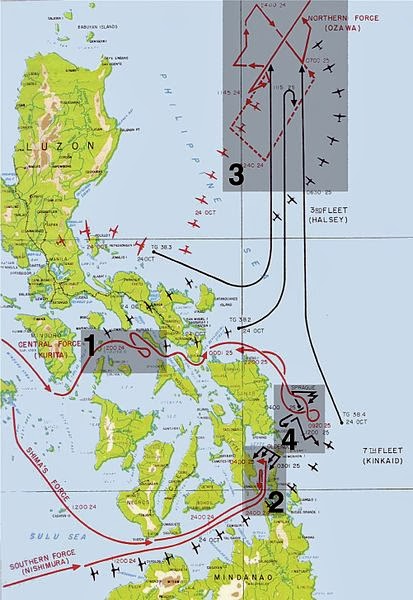“In no
engagement of its entire history has the United
States Navy shown more gallantry, guts and gumption than
in those two morning hours between 0730 and 0930 off Samar .”
Samuel Eliot Morison, Official Naval Historian
By the dawn of 25 October
1944 it looked like the battle – the biggest and most complex in
naval history – would end in a tremendous American victory. Submarines, surface
forces and naval aircraft each in turn pummeled the Japanese fleet and caused
great damage. Three enemy battleships, two cruisers, and two destroyers had
been sunk and the same number of ships had been badly damaged. Thousands of
Japanese sailors had lost their lives. Our own losses – one light carrier sunk,
a cruiser damaged, and a few dozen aircraft lost, as well as nearly a thousand
men killed, wounded, or missing - had been relatively light compared to the
damage inflicted. Admiral William “Bull” Halsey’s Task Force 38 was at that
moment hunting down the last of Admiral Ozawa’s carriers.
With the Japanese fleet now retiring in every direction, the 175,000 soldiers of the US Sixth Army in theLeyte beachhead and the fleet of transports lying
unprotected off shore were safe. The Liberation of the Philippines – the realization of MacArthur’s
promise to return and redeem the sacrifice of the men of Bataan and Corregidor – would proceed to its inevitable victorious
conclusion. The elaborate Japanese SHO-1
plan had ended in total failure.
At daybreak of October 25, theJOHNSTON JOHNSTON
With the Japanese fleet now retiring in every direction, the 175,000 soldiers of the US Sixth Army in the
At daybreak of October 25, the
Before that, Evans had served as Executive Officer of the ALDEN,
a “four piper” WWI-era destroyer that had survived the terrible early WWII battles
which annihilated Admiral Thomas Hart’s U.S. Asiatic Fleet. After the final
Allied defeat at the Battle of the Java Sea in
late February 1942, the ALDEN had escaped to Australia
Just 20 minutes
after sunrise, a patrol pilot over “Taffy Three” radioed a stunning
message, his excited voice crackling over the ships’ radios. “Enemy surface
force of 4 battleships, 7 cruisers, and 11 destroyers at 20 miles north your
task group and closing 27 knots.” Vice
Admiral Takeo Kurita’s First Striking Force – the most powerful enemy surface
fleet ever sortied - had suddenly appeared undetected and was bearing down on
the helpless beachhead. Nothing stood between the enemy and the complete
annihilation of the invasion forces except the tiny escort carriers of “Taffy Three”,
their few outdated Wildcats and bombers, and their outgunned destroyers. Large caliber shells where already striking the vulnerable carriers, esp. GAMBIER BAY.
The JOHNSTON
In describing
the suicidal charge of the destroyers, Fleet Admiral Chester Nimitz said “The
history of the United States Navy records no more glorious two hours of
resolution, sacrifice, and success.” The JOHNSTON Johnston








No comments:
Post a Comment